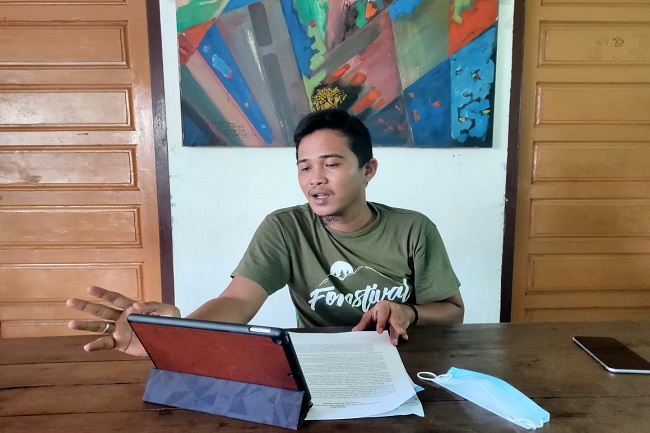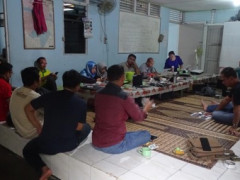Ministry of the Environment and Foresty Climate Change Event Photo Gallery
By Pantau GambutRace against time

Peatlands have various benefits, including storing 30 percent of the world's carbon, preventing drought, and preventing salt water from getting into agricultural irrigation. In addition, peatlands are also home to rare animals.
The conversion of peatlands into agricultural lands, plantations, and production forests poses a threat to the sustainability of natural peat swamp forests. Now only about 20 percent of South Sumatra's total peatlands remain.
The uncontrolled drainage system built by the concession holders has caused peatland subsidence and dryness. Pressure on peatlands continues in South Sumatra with increasing levels of degradation.
Peatland is often misunderstood as unused land. Actually, peatlands support the life of the surrounding community, flora, and fauna. Degraded peatlands are difficult to restore to their original state.
An international financial institution once released the costs paid by the government to restore the degraded peatlands after the big fires in 2015. The costs range from IDR 6 million to 36 million per hectare, with an average of IDR 12 million. This means that the cost needed to restore the 656,884 hectares of peatlands mandated to the Peatland Restoration Agency (BRG) is around IDR 7.88 trillion. This figure does not include losses suffered by the state due to the smog that affects economic activities, which is also another enormous figure.
Environmental Destroyer
The democratic system in electing state and regional leaders is one of the factors behind the lack of effort or attention to environmental conservation. The rulers tend to facilitate environmental damage such as through industrial pollution, deforestation, and land conversion.
Political costs are expensive in this country, corrupt practices by politicians at the national and regional levels alternately adorn the mass media coverage. To cover the political costs, policies and regulations are made as a red carpet for 'environmental-destroying investors’ under the pretext of improving the economy and people's welfare.
The environment is actually out of context in economic development. The market works according to the demand and supply mechanism. The amount of consumption and supply is never influenced by the limited capacity of nature from which the goods are produced.
Such a way of thinking will always favor investment for economic growth, which brings additional consumption and supply of goods, by erecting more factories and exploiting more natural resources. The built narrative is that economic growth is vital. The monetary value of environmental damage has never been calculated as a 'cost' to grow the economy.
Why the Omnibus Law? The Omnibus Law clearly has a very bad impact on environmental sustainability and stimulates conflict. Various environmental issues and agrarian conflicts that occurred during President Joko Widodo’s first term should be used as a reference. This shows that the state is still negligent in protecting the environment and maintaining Indonesia as an agrarian country.
Forest Watch Indonesia 2019 data explains that the licensing process is not well-managed. Many oil palm plantations have been operating even though they are not ‘clean and clear’ or have not obtained a permit. Around 68 percent of companies operating nationally do not have a land cultivation permit (HGU), covering an area of 14.8 million hectares consisting of 7.1 million hectares of oil palm plantations and 4 million hectares of land for other uses. The essence of investment is to improve the people's welfare.
However, it does not mean that we have the right to exploit everything without considering other aspects. We need to know that we are facing an increasingly massive ecological crisis. Not to mention, almost all investment activities in Indonesia have a bad record of environmental issues.
Deadlines
Indonesia has committed to low-carbon development in land-based sectors, which is reflected in the 2015-2020 National Medium-Term Development Plan (RPJMN).
In its Nationally Determined Contributions, the Government of Indonesia has increased the reduction of greenhouse gas emissions to 29 percent by 2030, by including the Aichi Targets. Indonesia has the largest tropical peatlands in the world, so low carbon development will not be achieved without sustainable peat management.
What about South Sumatra? Most swamps have peat soils, so the swampland management policy in South Sumatra should be based on the concept of sustainable natural resource development.
According to conservation principles, natural resources can be managed by combining protection, utilization, and conservation efforts in an integrated manner. In this context, peat swampland is not only seen as an ecosystem that needs to be protected, but also as a potential land that can be developed and utilized while still paying attention to the principles of sustainability.
In the living ecosystem, peat has an essential value to complement the rights of local communities. Therefore, we must protect and maintain the security and sustainability of peatlands for the present and future generations. And, it is also part of our cultural identity.
*This opinion was shared by the Executive Director of WALHI South Sumatra and Coordinator of Pantau Gambut South Sumatra, Hairul Sobri.
**THIS ARTICLE WAS PREVIOUSLY PUBLISHED ON GATRA.COM ON 25 OCTOBER 2021



